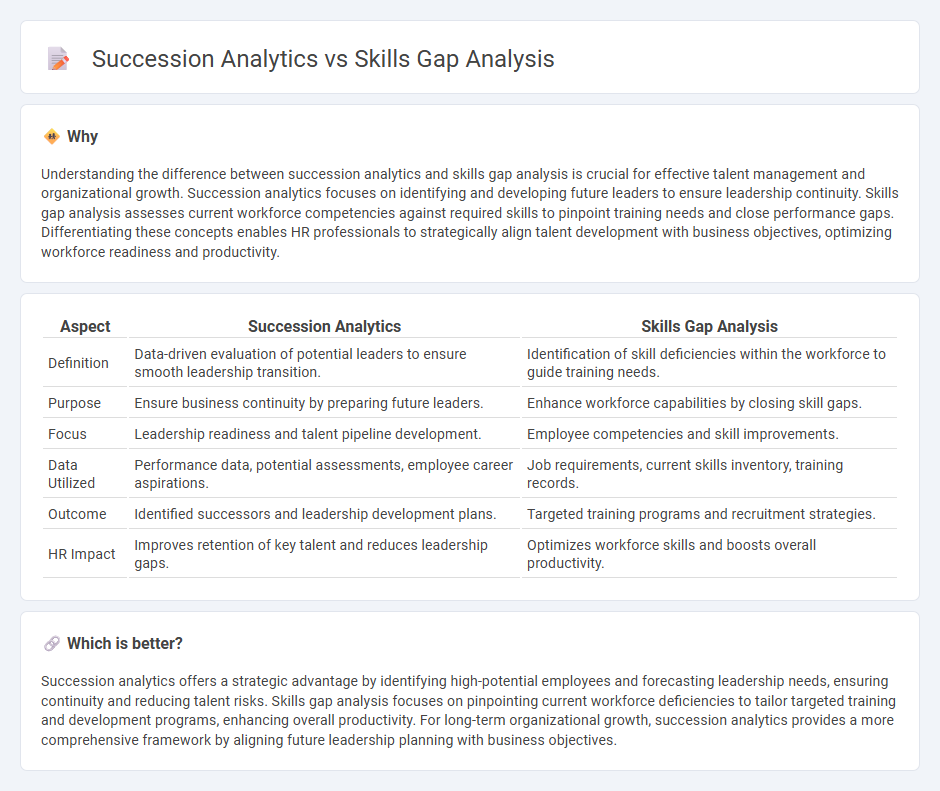
Succession analytics leverages data to identify and develop internal talent for future leadership roles, ensuring organizational continuity and minimizing risk. Skills gap analysis evaluates the existing workforce's competencies compared to desired skill sets, highlighting areas for targeted training and recruitment. Explore how integrating succession analytics with skills gap analysis can optimize talent management strategies.
Why it is important
Understanding the difference between succession analytics and skills gap analysis is crucial for effective talent management and organizational growth. Succession analytics focuses on identifying and developing future leaders to ensure leadership continuity. Skills gap analysis assesses current workforce competencies against required skills to pinpoint training needs and close performance gaps. Differentiating these concepts enables HR professionals to strategically align talent development with business objectives, optimizing workforce readiness and productivity.
Comparison Table
| Aspect | Succession Analytics | Skills Gap Analysis |
|---|---|---|
| Definition | Data-driven evaluation of potential leaders to ensure smooth leadership transition. | Identification of skill deficiencies within the workforce to guide training needs. |
| Purpose | Ensure business continuity by preparing future leaders. | Enhance workforce capabilities by closing skill gaps. |
| Focus | Leadership readiness and talent pipeline development. | Employee competencies and skill improvements. |
| Data Utilized | Performance data, potential assessments, employee career aspirations. | Job requirements, current skills inventory, training records. |
| Outcome | Identified successors and leadership development plans. | Targeted training programs and recruitment strategies. |
| HR Impact | Improves retention of key talent and reduces leadership gaps. | Optimizes workforce skills and boosts overall productivity. |
Which is better?
Succession analytics offers a strategic advantage by identifying high-potential employees and forecasting leadership needs, ensuring continuity and reducing talent risks. Skills gap analysis focuses on pinpointing current workforce deficiencies to tailor targeted training and development programs, enhancing overall productivity. For long-term organizational growth, succession analytics provides a more comprehensive framework by aligning future leadership planning with business objectives.
Connection
Succession analytics leverages skills gap analysis to identify critical competencies lacking in potential leaders, ensuring targeted development plans that close these skill gaps. By integrating workforce skills data with talent pipeline insights, organizations enhance succession planning accuracy and readiness. This connection enables strategic alignment of employee growth with future leadership needs, optimizing human capital investments.
Key Terms
**Skills Gap Analysis:**
Skills Gap Analysis identifies the specific competencies employees currently possess versus those required for optimal performance, enabling targeted training initiatives and improved productivity. It uses data on employee skills, job requirements, and organizational goals to highlight areas needing development, driving strategic workforce planning. Explore detailed methodologies and tools to effectively implement Skills Gap Analysis in your organization.
Competency Mapping
Skills gap analysis identifies the disparity between current employee competencies and organizational requirements, enabling targeted training programs. Succession analytics focuses on evaluating potential leaders' competencies to ensure seamless talent transitions and leadership continuity. Explore deeper insights into competency mapping to enhance workforce strategy and leadership development.
Training Needs Assessment
Skills gap analysis identifies deficiencies between current employee capabilities and required competencies, directly informing targeted training needs assessment. Succession analytics evaluates potential leadership pipelines and talent readiness, highlighting development priorities to ensure strategic role continuity. Explore how integrating both approaches enhances workforce training strategies effectively.
Source and External Links
Skills Gap Analysis: All You Need To Know [FREE Template] - A step-by-step guide on conducting a skills gap analysis to identify the difference between current employee competencies and required skills for achieving business goals.
How to conduct a skills gap analysis - A tutorial outlining the process of planning, identifying important skills, measuring current skills, and acting to close gaps at individual, team, or company levels.
Personal Skills Gap Analysis: How to Identify Which Skills You're Missing - A guide on performing a personal skills gap analysis to determine the skills needed for career advancement and professional growth.
 dowidth.com
dowidth.com